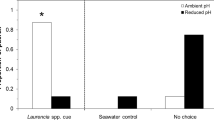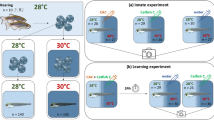Abstract
The use of small aquatic model organisms to investigate the behavioral effects of chemical exposure is becoming an integral component of aquatic ecotoxicology research and neuroactive drug discovery. Despite the increasing use of invertebrates for behavioral phenotyping in toxicological studies and chemical risk assessments, little is known regarding the potential for environmental factors—such as geometry, size, opacity and depth of test chambers—to modulate common behavioral responses. In this work, we demonstrate that test chamber geometry, size, opacity and depth can affect spontaneous, unstimulated behavioral responses of euryhaline crustacean Artemia franciscana first instar larval stages. We found that in the absence of any obvious directional cues, A. franciscana exhibited a strong innate wall preference behavior. Using different test chamber sizes and geometries, we found both increased wall preference and lowered overall distance traveled by the test shrimp in a smaller chamber with sharper-angled vertices. It was also determined through quantifiable changes in the chambers’ color that the A. franciscana early larval stages can perceive, differentiate and react to differences in color or perhaps rather to light transmittance of the test chambers. The interaction between innate edge preference and positive phototaxis could be consistently altered with a novel photic stimulus system. We also observed a strong initial preference for depth in A. franciscana first instar larval stages, which diminished through the acclimatization. We postulate that the impact of test chamber designs on neurobehavioral baseline responses warrants further investigation, in particular considering the increased interest in behavioral eco-neurotoxicology applications.
This is a preview of subscription content, access via your institution
Access options
Subscribe to this journal
We are sorry, but there is no personal subscription option available for your country.
Buy this article
- Purchase on Springer Link
- Instant access to full article PDF
Prices may be subject to local taxes which are calculated during checkout





Similar content being viewed by others
Data availability
Data from all experiments are available upon request.
References
Bai, Y., Henry, J. & Wlodkowic, D. Chemosensory avoidance behaviors of marine amphipods Allorchestes compressa revealed using a millifluidic perfusion technology. Biomicrofluidics 14, 014110 (2020).
Bownik, A. Daphnia swimming behaviour as a biomarker in toxicity assessment: a review. Sci. Total Environ. 601–602, 194–205 (2017).
Libralato, G., Prato, E., Migliore, L., Cicero, A. M. & Manfra, L. A review of toxicity testing protocols and endpoints with Artemia spp. Ecol. Indic. 69, 35–49 (2016).
Henry, J. & Wlodkowic, D. Towards high-throughput chemobehavioural phenomics in neuropsychiatric drug discovery. Mar. Drugs 17, 340 (2019).
Morgana, S., Estévez-Calvar, N., Gambardella, C., Faimali, M. & Garaventa, F. A short-term swimming speed alteration test with nauplii of Artemia franciscana. Ecotoxicol. Environ. Saf. 147, 558–564 (2018).
Bartolomé, M. C. & Sánchez-Fortún, S. Acute toxicity and inhibition of phototaxis induced by benzalkonium chloride in Artemia franciscana larvae. Bull. Environ. Contam. Toxicol. 75, 1208–1213 (2005).
Hellou, J. Behavioural ecotoxicology, an “early warning” signal to assess environmental quality. Environ. Sci. Pollut. Res. Int. 18, 1–11 (2011).
Campana, O. & Wlodkowic, D. Ecotoxicology goes on a chip: embracing miniaturized bioanalysis in aquatic risk assessment. Environ. Sci. Technol. 52, 932–946 (2018).
De Esch, C., Slieker, R., Wolterbeek, A., Woutersen, R. & de Groot, D. Zebrafish as potential model for developmental neurotoxicity testing. A mini review. Neurotoxicol. Teratol. 34, 545–553 (2012).
Blackiston, D., Shomrat, T., Nicolas, C. L., Granata, C. & Levin, M. A second-generation device for automated training and quantitative behavior analyses of molecularly-tractable model organisms. PLoS ONE 5, e14370 (2010).
Franco-Restrepo, J. E., Forero, D. A. & Vargas, R. A. A review of freely available, open-source software for the automated analysis of the behavior of adult. zebrafish. Zebrafish 16, 223–232 (2019).
Henry, J., Rodriguez, A. & Wlodkowic, D. Impact of digital video analytics on accuracy of chemobehavioural phenotyping in aquatic toxicology. PeerJ 7, e7367 (2019).
Henry, J. & Wlodkowic, D. High-throughput animal tracking in chemobehavioral phenotyping: current limitations and future perspectives. Behav. Processes 180, 104226 (2020).
Garcia, G. R., Noyes, P. D. & Tanguay, R. L. Advancements in zebrafish applications for 21st century toxicology. Pharmacol. Ther. 161, 11–21 (2016).
Rennekamp, A. J. & Peterson, R. T. 15 years of zebrafish chemical screening. Curr. Opin. Chem. Biol. 24, 58–70 (2015).
Cartlidge, R. & Wlodkowic, D. Caging of planktonic rotifers in microfluidic environment for sub-lethal aquatic toxicity tests. Biomicrofluidics 12, 044111 (2018).
Kohler, S. A., Parker, M. O. & Ford, A. T. Shape and size of the arenas affect amphipod behaviours: implications for ecotoxicology. PeerJ 6, e5271 (2018).
Kohler, S. A., Parker, M. O. & Ford, A. T. Species-specific behaviours in amphipods highlight the need for understanding baseline behaviours in ecotoxicology. Aquat. Toxicol. 202, 173–180 (2018).
Kohler, S. A., Parker, M. O. & Ford, A. T. High-throughput screening of psychotropic compounds: impacts on swimming behaviours in Artemia franciscana. Toxics 9, 64 (2021).
Inoue, T., Hoshino, H., Yamashita, T., Shimoyama, S. & Agata, K. Planarian shows decision-making behavior in response to multiple stimuli by integrative brain function. Zoolog. Lett. 1, 7 (2015).
Truong, L. et al. Multidimensional in vivo hazard assessment using zebrafish. Toxicol. Sci. 137, 212–233 (2014).
Zhang, S., Hagstrom, D., Hayes, P., Graham, A. & Collins, E.-M. S. Multi-behavioral endpoint testing of an 87-chemical compound library in freshwater planarians. Toxicol. Sci. 167, 26–44 (2019).
Akiyama, Y., Agata, K. & Inoue, T. Spontaneous behaviors and wall-curvature lead to apparent wall preference in planarian. PLoS ONE 10, e0142214 (2015).
Blaser, R. E. & Rosemberg, D. B. Measures of anxiety in zebrafish (Danio rerio): dissociation of black/white preference and novel tank test. PLoS ONE 7, e36931 (2012).
Harro, J. Animals, anxiety, and anxiety disorders: how to measure anxiety in rodents and why. Behav. Brain Res. 352, 81–93 (2018).
Faimali, M. et al. Old model organisms and new behavioral end-points: swimming alteration as an ecotoxicological response. Mar. Environ. Res. 128, 36–45 (2017).
Rashid, M. T. et al. Artemia swarm dynamics and path tracking. Nonlinear Dyn. 68, 555–563 (2012).
Forward, R. B. & Rittschof, D. Brine shrimp larval photoresponses involved in diel vertical migration: activation by fish mucus and modified amino sugars. Limnol. Oceanogr. 44, 1904–1916 (1999).
Gerhardt, A. Aquatic behavioral ecotoxicology—prospects and limitations. Hum. Ecol. Risk Assess. 13, 481–491 (2007).
Ford, A. T. et al. The role of behavioral ecotoxicology in environmental protection. Environ. Sci. Technol. 55, 5620–5628 (2021).
Bolker, B. M. et al. Generalized linear mixed models: a practical guide for ecology and evolution. Trends Ecol. Evol. 24, 127–135 (2009).
Author information
Authors and Affiliations
Contributions
J.H. and D.Wlodkowic developed and designed the experimental concepts. J.H., D.Williams, Y.B. and A.L. performed the experiments and collected and analyzed the data. J.H. wrote the manuscript. Y.B., A.F. and D.Wlodkowic reviewed and edited the manuscript.
Corresponding author
Ethics declarations
Competing interests
The authors declare no competing interests.
Peer review
Peer review information
Lab Animal thanks Maria Violetta Brundo, Jake Martin and Joseph Covi for their contribution to the peer review of this work.
Additional information
Publisher’s note Springer Nature remains neutral with regard to jurisdictional claims in published maps and institutional affiliations.
Supplementary information
Supplementary Information
Supplementary Table 1. Detailed statistical results from a GLMM.
Rights and permissions
About this article
Cite this article
Henry, J., Bai, Y., Williams, D. et al. Impact of test chamber design on spontaneous behavioral responses of model crustacean zooplankton Artemia franciscana. Lab Anim 51, 81–88 (2022). https://doi.org/10.1038/s41684-021-00908-7
Received:
Accepted:
Published:
Issue Date:
DOI: https://doi.org/10.1038/s41684-021-00908-7



